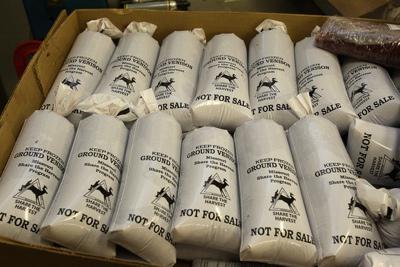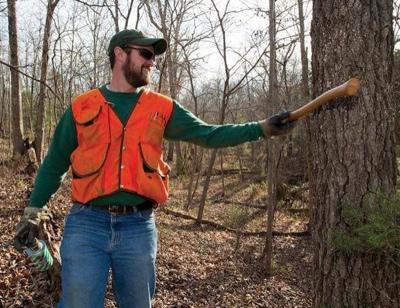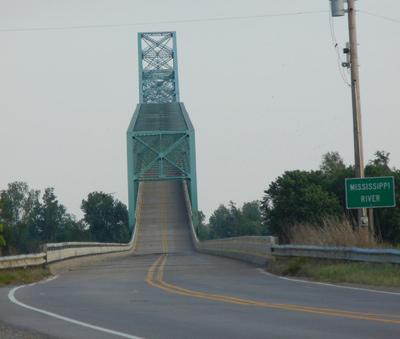
Dee Loflin, SMT Manager/Editor
The program is administered by the Conservation Federation of Missouri and MDC to help feed hungry Missourians. Share the Harvest orchestrates the efforts of thousands of hunters, numerous local supporting organizations, and more than 100 participating meat processors to get ground venison to people in need through food banks and food pantries around the state. Hunters donate their extra venison to participating meat processors who then prepare the donated venison by grinding it into one-pound packages that are given to food banks and food pantries for distribution to those in need.
Processing fees are covered entirely or in part by numerous local program sponsors, and statewide sponsors that include the Conservation Department, Shelter Insurance, Bass Pro Shops, the Conservation Federation of Missouri, Missouri Chapter Whitetails Unlimited, Missouri Chapter Safari Club International, Missouri Chapter National Wild Turkey Federation, Midway USA Inc., Missouri Deer Hunters Association, and the Missouri Food Banks Association.
Since the program started in 1992, Share the Harvest has provided more than 3.1 million pounds of lean, healthy venison to help feed Missourians in need.
For more information on Share the Harvest, visit http://mdc.mo.gov/node/2544.
Share the Harvest is administered by the Conservation Federation of Missouri and MDC to help feed hungry Missourians. Share the Harvest orchestrates the efforts of thousands of hunters, numerous local supporting organizations, and more than 100 participating meat processors to get ground venison to people in need through food banks and food pantries around the state. Hunters donate their extra venison to participating meat processors who then prepare the donated venison by grinding it into one-pound packages that are given to food banks and food pantries. Processing fees are covered entirely or in part by numerous local program sponsors, and statewide sponsors. High-res image available at http://mdc.mo.gov/node/26853

Dee Loflin, SMT Manager/Editor
“This is especially true if they have never had a timber sale before, or are concerned about the long-term health, wildlife habitat, and looks of their forested land,” said MDC Forestry Field Program Supervisor Brian Schweiss. “Through our Call Before You Cut service, landowners can get professional help from MDC foresters and private consulting foresters. It only takes a phone call to (877) 564-7483, or by going online to callb4ucut.com.”
Schweiss added that 83 percent of Missouri forests are privately owned and all forests provide important benefits to both those who own them and society in general.
“Forested lands play a vital role in providing clean air, recreational opportunities, wildlife habitat, forest products and clean water,” Schweiss said. “We work with and for many Missouri landowners to sustain healthy forests. From decades of research, we’ve learned that active forest management enhances the value of privately held woodlands.”
Schweiss offers landowners five reasons to Call Before You Cut:
1. Maximize timber income and save on taxes.
The difference between a low bid and high bid on a timber sale is typically substantial. Unaware landowners may take the first offer. A professional forester can assist with marking trees and estimating their value so the landowner knows what is being sold and the potential value. Equally important, professional foresters know what trees should not be cut for future forest benefits.
Tax savings may be another benefit. A professional forester can set a value for timber, known as the “basis,” for the year the landowner purchased the property. When selling trees, this basis can be deducted from the volume sold. In addition, sale revenue under the right conditions can be treated as capital gains income rather than ordinary income. Depending on how reported, landowners may be able to save a bit on taxes.
2. Harvest to increase quality, health and value of land.
Leaving the right trees is just as important as harvesting the right trees. Proper harvesting should leave trees with future potential. Depending on landowner objectives, these trees have wildlife value, future harvest value, and aesthetic value. Harvesting all good trees and leaving bad ones is referred to as “hi-grading.” When this occurs, a sale may be a “once in a lifetime” event. If the right trees are left, timber sales could occur on the same acres every 10–15 years.
Some larger landowners break their properties into different cutting units, have sales semi-annually, and rotate around the property on a set cycle. This provides regular income, encourages faster growth of desired trees, and maintains a healthy forest. Leaving the right trees will also maximize hunting and recreation opportunities.
3. Protect land for future generations.
Leaving property to their children is an important objective for many landowners. This legacy could be damaged through one poorly planned timber sale. Hi-grading and other harvests that take all sellable trees do not leave much potential for the next generation.
Practices such as forest thinning can help improve growing conditions for preferred species. This forest-stand improvement removes or harvests the worst trees, and provides needed growing space for remaining trees so they remain healthy and grow for a future sale, or wildlife needs.
4. Find the best logger for the job.
What sets apart a good logger from a bad logger? How do you ensure that the person harvesting trees on your property will not leave ruts and damaged trees? This concern is shared by many landowners. In Missouri, many loggers have completed the Missouri Forest Products Association’s Professionally Trained Harvester program. This teaches felling and skidding techniques that minimize damage to the forest. Some harvesters go one step further and become “Master Loggers.” These individuals have both completed extensive training, and have demonstrated excellent performance.
It is also vital that landowners have a detailed contract that specifies what will be done and not be done with a timber sale. A professional forester can help landowners develop contracts that protect the land and remaining trees from damage, and that specify payment methods for harvested trees.
5. Learn if harvesting is right for the situation.
Professional foresters can help landowners determine if the time is right for a timber harvest. Small trees may be harvestable, but may not have reached their full potential value. A nice white oak that is only 16 inches in diameter has value, but may only bring a lower lumber value. This same tree will increase in size and volume over time, and may sell at a higher veneer value at a later date. That is a double benefit for the landowner since they could receive a higher board-foot value, and the tree will have more board feet of volume.
MDC coordinates the “Call Before You Cut” program for Missouri in partnership with the Missouri Chapter of the Society of American Foresters, the U.S. Forest Service Northeastern Area State and Private Forestry, and the Missouri Tree Farm Program. The program encourages woodland owners to consult with a professional forester, in conjunction with a professional timber harvester or a master logger, before they make decisions about their forestland.
For more information and to receive a free Call Before You Cut packet, call (877) 564-7483, or go online to callb4ucut.com.

Submitted by
Dee Loflin, SMT Manager/Editor
Sikeston, Missouri -The Missouri Department of Transportation (MoDOT) is kicking-off a heightened pothole repair initiative today and would like the public's help. Through the month of March, MoDOT's Southeast District maintenance crews are committed to repairing potholes as quickly as possible. MoDOT will aggressively respond and patch potholes to keep highways smooth and safe for Missouri motorists.
"We want to get asphalt in the hole within a day of being notified a repair is needed. Our goal is to repair it before you drive the same road the next day," said MoDOT District Engineer Mark Shelton. "We know our aging infrastructure is prone to potholes this time of year, and we are making every effort to keep our roads safe and as smooth as possible."
MoDOT encourages motorists to report the location of potholes using the following tools:
• Call our toll-free Customer Service Center at 1-888-ASK-MODOT (888-275-6636)
• Use our Report a Road Concern form on the web at http://www.modot.org/southeast/
• Use your smart phone/tablet with a mobile friendly form at www.modot.org/roadconcern
• By email to comments@modot.mo.gov
• Through social media: Facebook at https://www.facebook.com/MoDOTSoutheast; or Twitter @MoDOTSoutheast.
Potholes form when temperatures warm up during the day, but continue to be cold at night. This is the main cause of potholes in highways and why they are prevalent during spring season. The rain and snow from winter leave moisture that seep into the cracks and joints in the pavement. When temperatures drop, the water freezes and expands the pavement. This expansion causes the pavement to bulge and crack. When cars drive over the bulging pavement, it eventually causes chunks of pavement to pop out.

Dee Loflin, SMT Manager/Editor
The closure is scheduled to begin on Friday, March 21, 2014 at 7:00 a.m. and will extend through Friday, March 28th, 2014 at 5:30 p.m.
The bridge will be open to all traffic from 5:30 p.m. to 7:00 a.m. each night.
Crews will be performing required annual safety inspection of the structure.

Submitted by
Dee Loflin, SMT Manager/Editor
The National Weather Service has postponed the Missouri Statewide Tornado Drill scheduled from tomorrow, March 4, until Thursday, March 6 at 1:30 p.m. The weather service says the postponement is due to the winter weather and other factors. The change to Thursday, which was the backup date, is for the entire state of Missouri.
The 40th annual statewide drill is part of Missouri 2014 Severe Weather Awareness Week, which runs from today through Friday, March 7.
On March 4, Missouri outdoor warning sirens will sound, indicating that Missourians should seek shelter during the statewide tornado drill. The safest shelter location is the basement or an interior room in the lowest level of a building. The drill is complete once everyone is accounted for in the designated shelters.
Missouri's Stormaware.mo.gov website includes detailed videos showing how to react to flash flooding and tornadoes and shelter in specific types of buildings – houses with and without basements, mobile homes, schools – and important information about tornado sirens and weather alert radios. The site also includes links to free severe weather texting services that can alert people across Missouri to upcoming severe weather.
The National Weather Service provides safety tips and educational information about each day of Severe Weather Awareness Week on the St. Louis Forecast Office site: http://www.crh.noaa.gov/lsx/?n=severeweek (Monday, Preparedness Day; Tuesday, Tornado Safety Day; Wednesday, Flash Flood Safety Day; Thursday, Severe Thunderstorm Day; Friday, NOAA Weather Radio Day).
Remember:
· Tornado watchmeans watch the sky. A tornado may form during a thunderstorm.
· Tornado warningmeans seek shelter immediately.
· An interior room without windows on the lowest floor is the safest shelter location.
· Do not seek shelter in a cafeteria, gymnasium or other large open room because the roof might collapse.
· Immediately leave a mobile home to seek shelter in a nearby building.
· Overpasses are not safe. An overpass' under-the-girder-type construction can cause a dangerous wind tunnel effect.
· If you are driving, you should stop and take shelter in a nearby building.
· If you are driving in a rural area, drive away from the tornado to the closest building. If you cannot get away, seek shelter in a roadside ditch. Protect yourself from flying debris by covering your head with your arms, a coat or a blanket. Be prepared to move quickly in case the ditch fills with water
· Never drive into water. It can take less than six inches of fast moving water to make a slow moving car float. Once floating, a vehicle can overturn and sink.
Helpful websites:
· NWS – Springfield, Flood Safety & Awareness site: http://www.crh.noaa.gov/sgf/?n=floodawarenessweek
· Missouri Department of Transportation Travelers Map: http://www.modot.mo.gov/
· Missouri Ready In 3 program: http://www.dhss.mo.gov/Ready_in_3/
· FEMA's Animals in Emergencies for Pet Owners DVD: http://www.fema.gov/individual/animals.shtm.
· Missouri StormAware: http://stormaware.mo.gov

